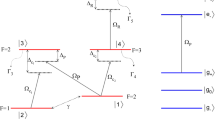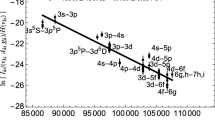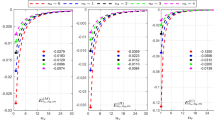The energy spectra for two electrons in a parabolic quantum dot are calculated by the quantization rule approach. The numerical results are in excellent agreement with the results by the method of integrating directly the Schrödinger equation, and better than those by the WKB method and the WKB-DP method.
Similar content being viewed by others
References
Jacak L., Hawrylak P., Wójs A., (1998). Quantum Dots. Springer-Verlag, Berlin
Ashoori R.C., (1996). “Electrons in artificial atoms”. Nature (Lond.) 379, 413
Yoffe A.D., (2001). “Semiconductor quantum dots and related systems: electronic, optical, luminescence and related properties of low dimensional systems”. Adv. Phys. 50, 1
Kohn W., (1961). “Cyclotron resonance and de Haas-van Alphen oscillations of an interacting electron gas”. Phys. Rev. 123: 1242
Maksym P.A., (1996). “Eckardt frame theory of interacting electrons in quantum dots”. Phys. Rev. B 53: 10871
Ashoori R.C., Stormer H.L., Weiner J.S., Pfeiffer L.N., Baldwin K.W., West K.W., (1993). “N-electron ground state energies of a quantum dot in magnetic field”. Phys. Rev. Lett. 71, 613
Maksym P.A., Chakraborty T., (1990). “Quantum dots in a magnetic field: role of electronelectron interaction”. Phys. Rev. Lett. 65, 108
Yannouleas C., Landman U., (2000). “Collective and independent-Particle motion in two-Electron artificial atoms”. Phys. Rev. Lett. 85: 1726
Pfannkuche D., Gudmundsson V., Maksym P.A., (1993). “Comparison of a Hartree, a Hartree-Fock, and an exact treatment of quantum-dot helium”. Phys. Rev. B 47: 2244
Ciftja O., Anil Kumar A., (2004). “Ground state of two-dimensional quantum-dot helium in zero magnetic field: perturbation, diagonalization and variational theory”. Phys. Rev. B 70: 205326
Merkt U., Huser J., Wagner M., (1991). “Energy spectra of two electrons in a harmonic quantum dot”. Phys. Rev. B 43: 7320
Harju A., Siljamäki S., Nieminen R.M., (2002). “Wigner molecules in quantum dots: a quantum Monte Carlo Study”. Phys. Rev. B 65: 075309
Reusch B., Grabert H., (2003). “Unrestricted Hartree-Fock for quantum dots”. Phys. Rev. B 68: 045309
Pino R., Villalba V.M., (2001). “Calculation of the energy spectrum of a two-electron spherical quantum dot”. J. Phys. Condens. Matter 13: 11651
Lee W.C., Lee T.K., (2002). “Low-energy states in a quantum dot obtained by the orbital integration method”. J. Phys. Condens. Matter 14: 1045
Nazmitdinov R.G., Simonović N.S., Rost J.M., (2002). “Semiclassical analysis of a two-electron quantum dot in a magnetic field: dimensional phenomena”. Phys. Rev. B 65: 155307
Chen W., Hong T.M., Lin H.H., (2003). “Semiclassical quantization rule for the bound-state spectrum in quantum dots: scattering phase approximation”. Phys. Rev. B 68: 205104
Kocsis B., Palla G., Cserti J., (2005). “Quantum and semiclassical study of magnetic quantum dots”. Phys. Rev. B 71: 075331
Johnson N.F., (1995). “Quantum dots: few-body, low dimensional systems”. J. Phys. Condens. Matter 7, 965
Reimann S.M., Manninen M., (2002). “Electronic structure of quantum dots”. Rev. Mod. Phys. 74: 1283
García-Castelán R.M.G., Choe W.S., Lee Y.C., (1998). “Correlation energies for two interacting electrons in a harmonic quantum dot”. Phys. Rev. B 57: 9792
Klama S., Mishchenko E.G., (1998). “Two electrons in a quantum dot: a semiclassical approach”. J. Phys. Condens. Matter 10: 3411
Langer R.E., (1937). “On the connection formulas and the solutions of the wave equation”. Phys. Rev. 51, 669
Brack M., Bhaduri R.K., (1997). Semiclassical Physics. Addison-Wesley, Reading
Ma Z.Q., Xu B.W., (2005). “Quantization rules for bound states of the Schödinger equation”. Int. J. Modern Phys. E 14, 599
Ma Z.Q., Xu B.W., (2005). “Quantum correction in exact quantization rules”. Europhys. Lett. 69, 685
Xu T., Cao Z.Q., Ou Y.C., Qishun Shen, (2005). “Two-dimensional quantization rule for the bound-state spectra in quantum dots”. Phys. Lett. A 341, 308
Puente A., Serra L., Nazmitdinov R.G., (2004). “Roto-vibrational spectrum and Wigner crystallization in two-electron parabolic quantum dots”. Phys. Rev. B 69: 125315
Cooper F., Khare A., Sukhatme U., (1995). “Supersymmetry and quantum mechanics”. Phys. Rep. 251, 267
Friedrich H., Trost J., (1996). “Phase loss in WKB waves due to reflection by a potential”. Phys. Rev. Lett. 76: 4869
Hruška M., Keung W.Y., Sukhatme U., (1997). “Accuracy of semiclassical methods for shapeinvariant potentials”. Phys. Rev. A 55: 3345
Yannouleas C., Landman U., (2003). “Two-dimensional quantum dots in high magnetic fields: rotating-electron-molecule versus composite-fermion approach”. Phys. Rev. B 68: 035326
Partoens B., Matulis A., Peeters F.M., (1999). “Two-electron artificial molecule”. Phys. Rev. B 59: 1617
Janssens K.L., Partoens B., Peeters F.M., (2002). “Single and vertically coupled type-II quantum dots in a perpendicular magnetic field: exciton ground-state properties”. Phys. Rev. B 66: 075314
Author information
Authors and Affiliations
Corresponding author
Rights and permissions
About this article
Cite this article
Gu, XY. Energy for Two-electron Quantum Dots: The Quantization Rule Approach. Found Phys 36, 1884–1892 (2006). https://doi.org/10.1007/s10701-006-9083-7
Received:
Revised:
Published:
Issue Date:
DOI: https://doi.org/10.1007/s10701-006-9083-7




